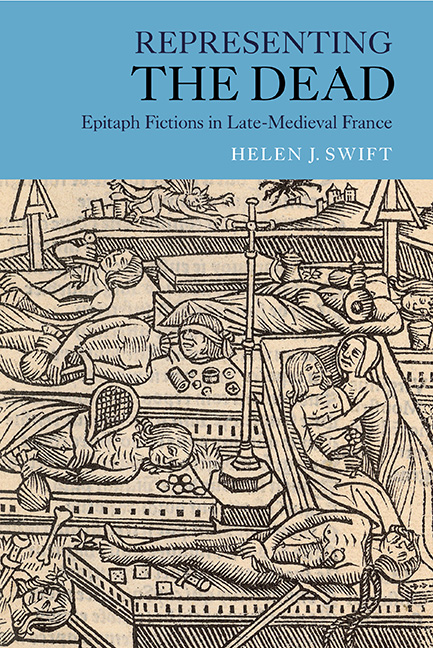Book contents
- Frontmatter
- Dedication
- Contents
- List of Illustrations
- Acknowledgements
- Note on Quotations
- List of Abbreviations
- Chronology of Epitaph Fictions
- Introduction: Representing the Dead
- 1 Framing Identity: ‘je suis’ and ‘cy gist’
- 2 Identity and/as Echo: the ‘Belle Dame’ querelle and Le Jardin de plaisance
- 3 Dying to be told: storytelling and exemplarity ‘selon le stile Jehan Bocace’
- 4 Placing the Dead: Cemeteries, Hospitals and Temples
- Afterword: Illustrating the dead
- Coda: Re-Member Me
- Appendix: Early Editions of the Jardin de plaisance et fleur de rethorique
- Bibliography
- Index
- Already Published
4 - Placing the Dead: Cemeteries, Hospitals and Temples
Published online by Cambridge University Press: 17 June 2021
- Frontmatter
- Dedication
- Contents
- List of Illustrations
- Acknowledgements
- Note on Quotations
- List of Abbreviations
- Chronology of Epitaph Fictions
- Introduction: Representing the Dead
- 1 Framing Identity: ‘je suis’ and ‘cy gist’
- 2 Identity and/as Echo: the ‘Belle Dame’ querelle and Le Jardin de plaisance
- 3 Dying to be told: storytelling and exemplarity ‘selon le stile Jehan Bocace’
- 4 Placing the Dead: Cemeteries, Hospitals and Temples
- Afterword: Illustrating the dead
- Coda: Re-Member Me
- Appendix: Early Editions of the Jardin de plaisance et fleur de rethorique
- Bibliography
- Index
- Already Published
Summary
Le lit ou il estoit couché
Estoit moult bel, spacieux, gent.
(Inventaire, vv. 117–18)[The bed in which he had lain was very handsome, spacious and elegant.]
Architectural frameworks such as cemeteries, hospitals and temples are concrete, static edifices. However, as we are dealing with the literary representation of these structures, they are also virtual, permeable, malleable units functioning as fictional textual entities or ‘types-cadres’. More specific than these general qualities of literarity, the structures in epitaph fictions are flexible in ways that call into question the nature of the space itself and what it presupposes: for example, one would normally anticipate finding a cemetery adjoining a church, so what happens when we find one at sea, as in Saint-Gelais's SH? And also in ways that explore the status of the occupants of that space, who inevitably contribute to its definition: how do we understand a hospital to which people repair to die, as in René's LCAE? We find ourselves, as readers, grappling yet again with negotiations between living and dead, presence and absence. The root cause of such complexity lies in the very notion of architecturally placing the dead. An act of siting, of holding the deceased in a given place, accords life beyond death, in terms of preserving someone's identity, at the same time as it affirms that they are dead and gone. It asserts their presence contained within a structure – deictically ‘la gisant’ in a cemetery, for instance – whilst simultaneously recognising them to be absent. Furthermore, each of the cemetery, hospital and temple structures is predicated on movement: cemeteries are markers of passing from life to afterlife; hospitals usually involve the passage of a patient in and out, from admission to discharge; temples commemorate a life that has passed/is past and thereby transmit forward name and renown. The case of temples in particular reminds us that what sets up the structure's existence in a text, what shapes the framework and provides narrative movement, is the persona/protagonist as a perceiving je: what s/he sees and hears (typically through the medium of dream vision) as s/he passes through her/his environment, and retrospectively reports having seen and heard.
Questions of place in epitaph fictions: ‘la vy’
The complexities adumbrated above indicate that careful methodological reflection is needed on the conceptual and narrative implications of ‘placing the dead’ before embarking on analysis of the three structures in turn.
Information
- Type
- Chapter
- Information
- Representing the DeadEpitaph Fictions in Late-Medieval France, pp. 201 - 264Publisher: Boydell & BrewerPrint publication year: 2016
